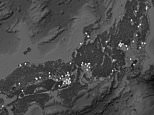
Ancient Japanese tombs are aligned so they all face the arc of the rising sun, according to a new study involving satellite images.
Hundreds of ancient burial mounds can be found dotted across the Japanese Islands, the largest of which are known as Kofun, and shaped like a keyhole.
Few details are known about the monuments, some of which are up to 1,600ft in length, because there are no written records, excavations are rare and limited to the smaller ones, and access is strictly restricted or even forbidden.
High-resolution satellite imagery allowed the team from the Polytechnic University of Milan in Italy to discover more about the mysterious monuments.
The satellite imagery revealed the relationship between the monuments, the landscape and the sky – finding they orientate to the arc of the rising sun.
This isn’t by chance, according to the researchers, who say it is in agreement with the Japanese imperial tradition, and the mythical origin of the dynasty, which considers them direct descendants of the Sun Goddess Amaterasu.
Ancient Japanese tombs are aligned so they all face the arc of the rising sun, according to a new study involving satellite images
Hundreds of ancient burial mounds can be found dotted across the Japanese Islands, the largest of which are known as Kofun, and shaped like a keyhole
ABOUT THE TOMBS
The funerary mounds, built between the third and seventh century CE, were found to contain items made of iron, weapons and the remains of people.
They have been attributed to the semi-legendary first emperors of Japan, with the smaller tombs dedicated to members of the royal family and aids.
The Daisen Kofun mound is approximately 1,600 ft long and 980 ft across at its widest point, rising 118ft above the surrounding terrain.
It is off-limits and protected by the Imperial Household Agency in the centre of Sakai City.
It is completely overgrown by vegetation, with the moat a haven for fish species.
Studies using satellite imagery revealed the entrance to all of the tombs face the arc of the rising sun.
They were built between the third and seventh century CE, with the most imposing of the monuments dedicated to the semi-legendary first emperors of Japan.
The smaller moments probably belonged to court officers, serving those first emperors, as well as to members of the royal family.
Among them is the Daisen Kofun, one of the largest monuments ever built on Earth, measuring 1,600ft long by 118ft height.
It is traditionally attributed to Emperor Nintoku, the sixteenth emperor of Japan, and belongs to a group of tombs recently given UNESCO world heritage status.
There are no written sources on these tombs, which makes uncovering their origins and details much harder, according to the Italian team.
Further adding to the problem for historians is the fact excavations of the tombs are rare, and limited to the smaller monuments.
This is because the largest tombs are considered being of the first semi-legendary emperors and, as such, are strictly protected by law.
Protection also extends to the outside, with many monuments fenced – which means archaeologists can’t even enter the perimeter of the grounds.
For these reasons, it is impossible to obtain accurate measurements of size, height and orientation, the team explained.
They were built between the third and seventh century CE, with the most imposing of the monuments dedicated to the semi-legendary first emperors of Japan
The satellite imagery revealed the relationship between the monuments, the landscape and the sky – finding they orientate to the arc of the rising sun
Furthermore, their sheer number of monuments further discourages any on field investigation – as the cost would be prohibitive.
This is why the team turned to high-resolution satellite images – which are described as a ‘powerful tool for remote sensing investigations’.
Study authors, Norma Baratta, Arianna Picotti and Giulio Magli of the Politecnico di Milano set out to deepen the knowledge of the relationships between these monuments and the landscape, in particular, with the sky.
The team measured the orientation of more than 100 Kofuns over the course of their satellite investigations.
Study authors, Norma Baratta, Arianna Picotti and Giulio Magli of the Politecnico di Milano set out to deepen the knowledge of the relationships between these monuments and the landscape, in particular, with the sky
This isn’t by chance, according to the researchers, who say it is in agreement with the Japanese imperial tradition, and the mythical origin of the dynasty, which considers them direct descendants of the Sun Goddess Amaterasu
Few details are known about the monuments, some of which are up to 1,600ft in length, because there are no written records, excavations are rare and limited to the smaller ones, and access is strictly restricted or even forbidden
They found a strong connection of the Kofun entrance corridors with the arc in the sky where the Sun and the Moon are visible every day of the year.
They show that the orientation of the hugest keyhole-shaped Kofuns to the arc of the Sun rising/shining, in particular, the Daisen Kofun is oriented towards the Sun rising at the winter solstice.
The findings have been published in the journal Remote Sensing.
Sun Goddess Amaterasu: A major deity of the Shinto religion
The Sun Goddess Amaterasu is one of the major deities in the Japanese Shinto religion, portrayed in the earliest Japanese texts, the Kojiki, dating to 712 CE.
She was the ruler of the heavenly realm Takamagahara and the mythical ancestress of the Imperial House of Japan via her grandson Ninigi.
Alongside siblings Tsukuyomi, the moon god, and the storm god Susanoo, Amaterasu is considered to be one of the “Three Precious Children’ – or the most important children of creator god Izanagi.
The mythical origin of the dynasty of the Japanese Emperors considers them as direct descendants of the Sun Goddess Amaterasu.
Source link
CHECK OUT: Top Travel Destinations
READ MORE: Travel News



